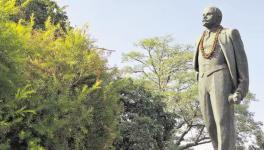New Bhagat Singh Book Rebuts British Rule of Law in Colonial India

From the beginning of the 21st century, there has been a significant interest among foreign scholars in British, American and some other international universities to do research on Bhagat Singh and his comrades.
Kama Maclean and Chris Moffat’s research-based books have already contributed to the literature on Singh. Daniel Elam and Christopher Pinney are other important names on the list of contributors. Among Indian researchers abroad, Neeti Nair and Maia Ramnath are continuously researching Indian revolutionary movements.
Now, Satvinder Singh Juss, who is from a Punjabi background and is a law professor and practising barrister in London, has joined the list. His book The Execution of Bhagat Singh: Legal Heresies of the Raj is another study on the sham trial of Singh after the earlier celebrated book by AG Noorani The Trial of Bhagat Singh: Politics of Justice, which was published in 1996.
On the flap on Juss’s book, Kim A. Wagner, known for his book on Jallianwala Bagh, has hit the nail with his short comment: “The book offers a powerful rebuttal of the tired cliché that the British introduced the rule of law in colonial India.”
A 2006 book titled The Blood Never Dried: A People’s History of the British Empire, written by John Newsinger, mentions the so-called justice system of British colonial rule in Asian and African countries, where so much human blood was splintered to continue the imperial loot that it never dried as a poetic phrase used by British poet Earnest Jones in his celebrated poem The Revolt of Hindostan, based on the 1857 Indian war of Independence.
Juss’s book was first published by Amberley Publishing in the UK in 2020 and its Indian edition was published by HarperCollins Publishers India in 2021. The title to the preface of the book’s Indian edition is ‘Why Bhagat Singh Matters’ and begins by referring to the historic and the largest labour protest in history of 125, 000 farmers. Subsequently, Juss refers to Singh’s uncle Ajit Singh, who led a similar farmer’s protest against anti-farmer laws in 1907.
The author in his preface refers to the April 8, 1929, arrest of Singh (and Batukeshwar Dutt) after they hurled bombs at the Central Legislative Assembly, Delhi, as a watershed moment in his life. He refers to Singh’s jail notebook and other writings and the book on Vladimir Lenin read by him a few hours before his execution.
The contents of the book include a prologue and 11 chapters apart from appendices, notes and a bibliography. The appendices include eight pages of details of Singh’s case files in the Punjab Archives, Lahore, not known before and many letters and other documents reproduced in scanned form, which are a valuable part of the book.
In the prologue, the author refers to the story of the tomb of Anarkali inside Punjab Archives, to which he mistakenly describes as ‘The Bhagat Singh Archives’. Yes, 134 case files of the Lahore conspiracy case are part of the Punjab archives, the brief details of which are shared for the first time in the appendix of this book.
Many open addresses of revolutionaries as well as secret ones are also referred—such as a factory on Ravi Road, a rented house in Gwal Mandi, another house in Mozang and one place in Kashmir building on Mac Leod Road. A journalist Amara Ahmad was planning to research the footsteps of Singh in Lahore at one time though the present status of her research is not known. Ironically, Juss was given full access to the otherwise inaccessible Punjab Archives, Lahore, but was denied similar access to the National Archives of India because of his non-resident Indian status as he describes in his prologue.
Every chapter of the book begins with a suitable Urdu couplet with an English translation—such as from Habib Jalib, Akbar Allahabadi, Faiz, Sahir Ludhianvi, etc. The first chapter, ‘Coercive Colonial Legalism’, brings out the so-called justice of the colonial regime, which itself was based on the principle of coercion of Indian or any colonised people, the features of which are detailed in this chapter.
Another chapter ‘The Slipper and the Magistrate’ narrates how Premdatta Verma, the youngest co-accused in the Lahore conspiracy case, threw a slipper at approver Jai Gopal, provoked by his gestures. Later, the revolutionaries were brutally attacked in front of Magistrate Pandit Sri Kishen, who was acting more as an executive magistrate than a judicial one.
A full chapter is devoted to the glorious hunger strike/s by the revolutionaries during which Jatin Das died on September 13, 1929. Muhammad Ali Jinnah had commenced his speech at the Central Assembly on September 12 by mentioning Das.
The book also mentions how the British were introducing ordinances arbitrarily when they were not able to get them passed in the Assembly as they had more nominated members than elected ones. The Indian resistance, whether in the Assembly or at courts by nationalist advocates at the Lahore Bar, is also presented in great detail.
One full chapter “‘Inquilabi’ Justice Agha Haider” mentions the great role played by Saharanpur-born Justice Agha Haider, who was nominated as a member of the Special Tribunal in May 1930 and was fair to the Lahore conspiracy accused as a High Court judge. Justice Haider threw away the man sent by the British to bribe him to convict the accused. Finally, the colonial rulers got rid of Justice Haider through Chief Justice of Punjab High Court, Sir Shadi Lal, on the excuse of the reorganisation of the tribunal.
Justice Haider later became a member of the UP Assembly and a condolence resolution passed by the Assembly is given as an appendix. Justice Haider, born in 1876, died on February 5, 1947, a few months before independence. His descendants still live in the same house in Saharanpur as the family decided not to migrate to Pakistan during the Partition.
Singh’s sham trial is exposed as it was held in the absence of the accused and in heresies of the Raj, it is underlined that the judgement was predetermined. To quote the author, “In fact, the Tribunal’s bias is clear from how badly the judgement was drafted.” (Page 179)
The Execution of Bhagat Singh is one of the better books written on the legendary revolutionary and freedom fighter in the last decade or so. The book also focuses on Singh’s personality as a Marxist thinker, which is an eyesore for the current Indian government trying to appropriate him as a popular icon but sans his revolutionary thought.
Singh’s power even after his death is so overwhelming that despite the government’s best efforts to suppress his revolutionary thought, it became the strength of the historic movement of farmers against the three farm laws. The farmers got inspiration and strength from Singh’s revolutionary ideas and emerged victorious. Even after his execution, Bhagat Singh lives more powerfully as he himself had foreseen while consciously choosing martyrdom—Juss’s book underlines this strength.
The writer is a retired professor of JNU and an honorary adviser of the Bhagat Singh Archives and Resource Centre, Delhi.
Get the latest reports & analysis with people's perspective on Protests, movements & deep analytical videos, discussions of the current affairs in your Telegram app. Subscribe to NewsClick's Telegram channel & get Real-Time updates on stories, as they get published on our website.
























